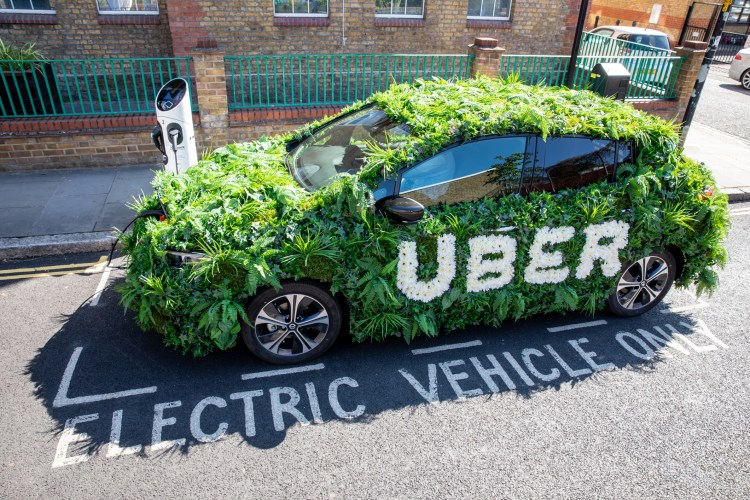Uber last year announced a three-year, $10 million investment in sustainable transportation, and it became a signatory to the Step Up Declaration for carbon mitigation and energy efficiency. This morning at a press conference in San Francisco attended by CEO Dara Khosrowshahi, it doubled down on its sustainability pledges by committing to power all of its offices with renewable electricity by 2025. Additionally, it expanded its collaborations with startups EVgo and Powerdot to build out electric vehicle (EV) charging infrastructure internationally. And the company said that in the coming months, it would disclose the environmental impact of rides on its platform.
“Cities face a seemingly impossible challenge over the next three decades: make room for an expected doubling of mobility demand while cutting transportation’s climate emissions more than 60% from 2010 levels,” wrote Uber in a blog post. “CO2 emissions from the transportation sector already account for nearly one-quarter of the global total, on an energy basis … Mobility as usual is unsustainable. Between now and 2050, we need to find every way possible to help move a lot more people more efficiently and with significantly less climate impact.”
To this end, Uber said it’ll continue to expand Uber Transmit, its partnership with transit agencies in Denver, London, Boston, Sydney, and Chicago to help late-night workers get to jobs and people with disabilities access transportation. In addition, Uber said it’ll explore with EVgo ways to improve U.S.-based EV owners’ access to charging, and that it’ll work with Powerdot to build a dedicated fast-charging infrastructure to support EV drivers in Lisbon and Porto, Portugal. (Both cities are participants in Uber’s Green pilot project, which offers rides in all-electric or hybrid cars.)
On the UberEats side of its business, Uber said it’ll roll out a feature in the coming months that’ll allow diners to request straws, utensils and other additional items when they place their orders. Restaurants will no longer include them by default.
June 5th: The AI Audit in NYC
Join us next week in NYC to engage with top executive leaders, delving into strategies for auditing AI models to ensure fairness, optimal performance, and ethical compliance across diverse organizations. Secure your attendance for this exclusive invite-only event.
“Research suggests that single-use plastics harm the environment by disrupting the productivity of natural systems like our oceans and clogging urban infrastructure,” Uber wrote in a blog post. “We know this is just a first step towards the reduction of plastic waste, but we’re excited to think more about how we can do better for our planet and the impact of food delivery around the world.”
Lastly, Uber said it plans to make public its rides’ contribution to carbon emissions globally. It specifically intends to share travel efficiency, a ratio of the total distance traveled by each passenger inside a vehicle over the distance traveled by said vehicle, and carbon intensity, which evaluates the emissions required for every mile traveled by every passenger on its platform.
Uber says it consulted experts including Fehr & Peers and the World Resources Institute (WRI) to standardize the two metrics, and it says it’ll host with WRI several workshops in the coming months to gather input from city representatives, researchers, and others.
The new pledges build on Uber’s Clean Air Plan in London, which aims to ensure every car in the Uber network is fully electric by 2025. (To date, Uber says that it’s been able to set aside £50 million, or $61.87 million, to help transition drivers into electric vehicles.) Separately, Uber recently kicked off a yearlong pilot to provide cash incentives to EV owners, with the goal of facilitating at least five million trips over the next 12 months.
Ride-sharing companies including Uber rival Lyft have historically faced criticism for their poaching of public transportation customers. Bruce Schaller, a transit consultant who served as deputy commissioner for traffic and planning in New York City, told The Verge that about 60% of Uber and Lyft riders in large cities “would have taken public transportation, walked, biked or not made the trip” if ride-hailing hadn’t been available.
In particular, Uber has been accused of muddying the waters around its operations’ sustainability with opaque (or even biased) methodologies. In a 2015 blog post touting its UberPool service, it asserted that it prevented 120 metric tons of CO2 emissions over a roughly one-month period. But Vice noted that Uber failed to disclose the launch of three separate promotions for discounted UberPool fares during the same time period, which might have artificially inflated the numbers.
Uber more recently reported that in 2017, drivers on its platform served 35 million riders in UberPool and Express Pool trips. If these riders had instead driven by themselves, it claimed, cities might have seen an additional 314 million vehicle miles and 82,000 metric tons of carbon dioxide emissions.
The newly announced initiatives are a direct response to those criticisms, but it won’t be clear whether they’ll satisfy Uber’s most vocal critics until after the first metrics become available.
“As we grow, we have a tremendous responsibility to help the rides we facilitate use public resources as efficiently as possible, especially roads and air, and to find more sustainable ways to help get people and things from A to B,” wrote Uber, adding that its platform now moves “people and things” more than 18 million times a day. “Getting this right can help reduce the carbon impact of our platform, help drivers save on fuel, help riders get affordable, lower impact travel options, and help cities unlock more efficient mobility options.”

